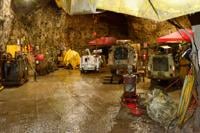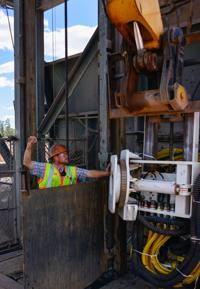Uranium mining in the Grand Canyon: A dispute over water and geology
To critics, the mine poses too much of a risk.
To the company, that claim is unsubstantiated.
Amber Reimondo, energy director for the Grand Canyon Trust, said the risk of uranium and other minerals migrating out of the mine after mining is completed is too great and too uncertain to allow further mining operations.

Equipment maintenance bay at the bottom of the 1,400 foot deep Pinyon Plain mine shaft in northern Arizona, 12 miles south of Grand Canyon Village, Arizona in May 2024.
Scott Weiser scott.weiser@gazette.com

Equipment maintenance bay at the bottom of the 1,400 foot deep Pinyon Plain mine shaft in northern Arizona, 12 miles south of Grand Canyon Village, Arizona in May 2024.
“There will still be the presence of uranium and other minerals like arsenic and lead present when they’re finished mining,” Reimondo told The Denver Gazette. “So, it creates basically a Pandora’s box, where they expose uranium and other minerals to the elements and mobilize it.”
Reimondo also claimed that the company’s plan to backfill the mine shaft and seal off water seepage into the mine shaft as part of the closure process “is not a practical solution.”
“That might be a temporary solution, but at some point water finds a way and will again start entering that fractured space where the mine company will no longer be there to pump out the water,” said Reimondo.
Curtis Moore, senior vice president of marketing and corporate development at Lakewood-based Energy Fuels Resources Inc, said that’s the kind of “lie” perpetuated by critics that’s difficult to combat.
“The Havasupai put a statement out that says we’ve already polluted an aquifer,” said Moore. “We are wondering what to do about this because this stuff starts to become an article of faith in people.”
“‘Oh, they’re polluting aquifers.'”
“It’s a lie,” Moore said. “We have not.”
Moore called the accusation “defamation.”

Energy Fuels Resources Inc. employee Russell Jessup directs a telehandler forklift operator while preparing to attach a Boart-Longyear Stopemate pneumatic drill control head to the ore bucket of the mine shaft hoist for lowering to the bottom of the shaft at 1,400 feet below ground level. May 2024
Scott Weiser scott.weiser@gazette.com

Energy Fuels Resources Inc. employee Russell Jessup directs a telehandler forklift operator while preparing to attach a Boart-Longyear Stopemate pneumatic drill control head to the ore bucket of the mine shaft hoist for lowering to the bottom of the shaft at 1,400 feet below ground level. May 2024
The Colorado company mining this area is at the frontlines in the battle over uranium mining near the Grand Canyon. The outcome of that battle offers all kinds of implications for Americans — jobs, energy, the environment, the economy, national security.
Uranium fuels nuclear power, which, to many supporters, is the only real path to a sustainable, efficient, plentiful and practically carbon-free energy. To critics, its risks, including vulnerable plants and radioactive waste, far outweigh the benefits. Uranium mining is also caught in the crossfire between environmentalists and their allies in government seeking to transition away from “fossil” energy, and the oil and gas industry and its supporters, who argue that a balanced energy portfolio is the more practicable and reasonable path.
Moore rejected Reimondo’s claim that the area around the mine is fractured and that seepage from the mine would end up contaminating aquifers.
He said the aquifer lying above the ore body is a sealed-off “perched” aquifer containing water that testing shows to be more than 10,000 years old. He noted that 10,000 years is the scientific limit for determining the age of water. It could be millions of years old.
“We know that this is a perched aquifer because the water’s very old,” said Moore. “One of the many reasons it’s perched is that if there was some connection between this aquifer and something else somewhere else, this water would’ve flowed out of here a long, long, long time ago. It wouldn’t be there.”
“Just the fact that this really old water is sitting there is one of the 50 indications that this is just a little isolated perched aquifer,” Moore added. “This is the stuff that’s flowing into the shaft right now, and it’s on the order of 15 to 20 gallons per minute. It’s like a couple of garden hoses.”
According to the company’s water permits from the state, potentially contaminated water pumped out of the lined bottom of the mine shaft has to be treated to remove any contaminants. The method used is evaporation. Pumped water is broken up into a fine spray that evaporates the liquid, while depositing any solid contaminants in a lined evaporation pit on the surface. The deposited material is regularly removed and disposed of according to EPA regulations at a licensed disposal site, Moore said.
Moore also said that uncontaminated water from the aquifer that is seeping into the upper part of the mine shaft is being captured by a collar around the inside of the shaft above the uranium lode. That captures the seepage, which is pumped to the surface and provided to livestock producers.
Moore said the public has a misunderstanding about underground aquifers. He said most people think aquifers are lakes or flowing rivers that are all connected underground and that contamination of one, or part of one, will contaminate all of the underground water.
The truth, he said, is that deep aquifers like this can be large reservoirs of water millions of years old locked in permeable sandstone layers that can be and often are completely isolated from one another, not only within the same underground layer through pinching out and faults that interrupt flow, but also vertically separated from other aquifers by layers of impermeable stone.
Many of these aquifers have no outlet to the surface, unlike the one that feeds springs that form Havasu Creek and it’s famous travertine pools on the Havasupi Reservation, some 40 miles away from the mine.
At the mine site, the upper aquifer is sealed off by layers of impermeable rock, while the Redwall-Muav aquifer, thousands of feet below, is sealed off from other adjacent pockets below the mine and is not hydrologically connected to the source water of Havasu Creek, Moore said, citing geological surveys.
Reimondo is critical of the company’s research on subsurface water flows and says the area is “highly fractured” and “not well understood.”
“They’re using models,” Reimondo said. “And those models also make some pretty broad assumptions, including that there’s no fracture down through the rock below the mine or even near the mine.”
Moore said the hydrogeology surrounding the ore deposit shows no evidence of such fracturing, and the slope of the underground layers is away from the canyon and the Havasu Reservation.
”Havasu Creek is nearly 40 miles away from the mine,” Moore said. “The Grand Canyon area is a geological uplift and water flows south, away from the canyon, not northwest towards Havasu Creek.”
At Grand Canyon Village, on the south rim, the uplift brought it to 7,000 feet above sea level. The mine surface lies at 6,495 feet above sea level, according to the U.S. Geological Survey.
Besides, Moore said, even if there were a hydraulic connection to the Redwall-Muav aquifer from the mine, the amount of seepage in the mine would take thousands of years to travel 40 miles, and by the time it arrived, any uranium in it would be so diluted that it would be indistinguishable from natural background radiation from uranium that is already present in the Havasu Creek outflow.
According to three different scientific studies of radioactive elements in the Grand Canyon, uranium levels in Havasu Creek are below what the EPA says are acceptable for drinking water.
A square kilometer of earth, 30 cm deep, will typically contain a ton or more of uranium, the Nuclear Regulatory Commission said.
”Uranium is abundant and is found almost everywhere in surface soils,” Moore said.






